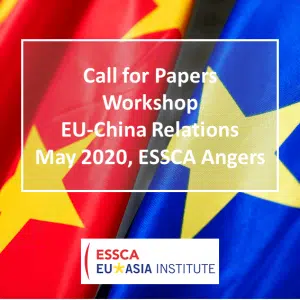ESSCA EU-ASIA INSTITUTE Workshop on EU-China Relations
CALL FOR PAPERS
‘EU FACING GLOBAL CHINA: SOCIOLOGICAL, COMPARATIVE, AND RISK ASSESSMENT OF BELT AND ROAD INITIATIVE’
Angers, 14–15 May 2020
Workshop purposes
Have an “inside-out” analysis of global China’s strategic action system around “Belt & Road Initiative” (BRI).
China’s recent strategic reach from a normal globalizing economy to an extraordinary globalized power results from its internally coherent action system. This globalization system has BRI as core, supported and supplemented by national manufacturing strategies (Made in China 2025, Internet Plus Plan), techno-economic paradigm trans-formation (5G telecommunication technology and digital platform innovation), international political advocacy (new order of global governance, human destiny community, and ‘great power diplomacy’), “relationship network” de-ployment (overseas medias and external communications, person-to-person dialogue, Confucius institutes, so-called ‘united frontiers’ building), and global outreach of Chinese regional city clusters such as the Grand Bay Area of Guangdong-Hong Kong-Macau, etc. BRI can be regarded as a volunteered strategy, but it is in fact more a strategy as practice, as well as the continuation and replication of the very Chinese system of society at a new global level. To gain some new insight into the BRI and its move for the EU, the workshop will put them in the con-text of a broader Chinese action system, break down this system in pieces, and take a “the-other-way-around” perspective to understand the natures, logics and characteristics of current globalization of China.
Establish an objective assessment of risks and challenges of China’s current global actions on EU-China relations.
Different from US think tank reports which adopt more and more often negative geopolitical assumptions on BRI on one hand, and Chinese main steam research which has the habit to blur the borders between academic analysis and BRI communicative promotion on the other hand, this workshop will invite more disciplinary approaches with sociological, historical, institutional, and comparative theoretical foundations for assessing the risks and challeng-es of BRI based on objective analysis. In terms of implications on more coherent policy strategies, it is believed that both EU and China, as well as third parties in the world, will benefit from such neutral and systemic evaluation.
Comparing BRI to China’s Globalization 1.0
There has been significant expansion and globalization of Chinese capital, people, and ideas since the late 1990s. Before 2013, Chinese firms adopted “going out” strategies alongside with the government’s “going out” policy and carried out Foreign Direct Investment (FDI) through greenfield projects, alliances, and mergers and acquisitions (M&A), etc. They were basically converging to business models of US, Japan and European multinational firms and market-led FDI models. This can be regarded as China’s globalization version 1.0, which was a rather entrepreneurial-type and business-oriented globalization process. Yet Western countries were frequently worried about their political motives and the background of State-owned Enterprise (SOE). However, flows of capital, people, and ideas from China continued to increase, and greatly diversify over the last two decades to reach fields as diverse as energy, trade, transport, media, education, finance, and so on. Without BRI, China probably would have gone down this path of clas-sic globalization with a not so heavy hand of State government.
Breaking Down BRI as Strategic System of Global China 2.0
After 2013 China entered into its globalization 2.0 period, represented and spearheaded by the BRI, that is a full-fledged global expansion movement led by State government. “BRI” has been advocated as China’s new development strategy and framework for connectivity and cooperation among countries primarily between itself and the rest of Eurasia. It has already attracted over 100 countries and international organizations to join, and enjoyed support from Beijing-led Asian Infrastructure Investment Bank. Almost all Chinese “going out” activities of business companies are now collected under the banner of BRI. Around it, the world and the EU see a brand-new version of State-organized globalization with Chinese characteristics emerging.
1. Why State government and SOE are global China’s backbones and driving forces in BRI?
The Chinese version of globalization and more recent Belt and Road Initiative reflect its domestic situation of capi-tal over-accumulation, its desire of adequate supply of raw materials and energy, as well as its interest in fostering the global competitiveness of its enterprises by exporting overcapacity of production. In the process, China’s FDI has increased globally, particularly in Africa, Latin America, Asia, and Europe. This has resulted in China becoming the most important source of FDI in the world with 158.29 billion US$ annually in 2017. At empirical level, key ac-tors of BRI projects in the EU need to be surveyed and interviewed in a systemic way. At theoretical level, institu-tionalist theories such as Theorie de Régulation might be mobilized to put Chinese State government and State-owned Enterprises under contemporary capitalism framework, to explain the striking forces of BRI for global China.
2. Is BRI the global expansion of Chinese capitalist model?
BRI has three main interwoven economic arms: 1) industrial parks with industrial capacity exportation, 2) infra-structure investment and building, and 3) developmental banking and long-term financial support. BRI projects in these three areas are neither the sort of aid project by international financial institutions such as the World Bank and the International Monetary Fund traditionally associated with the Washington Consensus, nor the sort of joint development project expected by Chinese government. An interesting question is the connection between the transformations of China’s domestic economic development strategies and accumulation regimes on the one hand, and the expansion and globalization of China’s reach, on the other. Are BRI projects geographic expansion and ef-fort to sustain the Chinese domestic manufacturing-led growth and the recent finance-led regime of accumulation abroad? In particular, what are the economic and political goals of the expansion of Chinese capital beyond “accu-mulation for accumulation’s sake”? And what impact or consequence of such “hyper accumulation regime” with Chinese characteristics will have on the EU?
3. Will the global China technology and digital network make BRI an innovation powerhouse?
The implementation of Made in China 2025, the Internet Plus Plan, and the recent Intelligent Manufacturing Plus Plan, 5G telecommunication rollout, AI, robotics, advanced manufacturing, and digital platform economy are all supporting the global expansion of Chinese industrial power. It looks granted for China that BRI investment is to feed the long term technology deployment abroad, from innovation down to the rise of environmentally fit produc-tion units; many industrial sectors, including in “old” industries like steel, metallurgy or fertilizers do show an in-creasing fine-tuning between modernisation/closing old production capacities and, spreading technological ad-vantages along the BRI. Will BRI spread the new, acquired, comparative advantages of China to EU? Will it drive new/further Chinese innovation? Can it enable or conversely does it threaten innovation in the West? These are practical question global and national leaders need to take a stand on when treating BRI.
4. Chinese “global governance new order” and “global human destiny community”: political advocacy of real power or ideology for BRI?
The United States (US) Trump administration’s withdrawal from the Trans Pacific Partnership (TPP) gives China an opportunity to strengthen its position in world trade. Beijing has been pushing its own regional free-trade pacts which include both the Free Trade Area of the Asia Pacific (FTAAP) and the Regional Comprehensive Economic Partnership (RCEP) as competitors to the TPP. The Trump administration launched the United States on a protec-tionist course by stating that “protection will lead to great prosperity and strength.” Contrarily, China’s leader Xi Jinping at the World Economic Forum in 2017 called for globalization, declaring “pursuing protectionism is like lock-ing oneself in a dark room. While wind and rain may be kept outside, that dark room will also block light and air” (c.f. also Xi Jinping’s speech at the 19th National Congress of the Communist Party of China). China has long been a protectionist and isolationist economy even after it joined WTO in early 2000s while the US was a free and open economy following its victory in the World War II. At levels of world economic order, political vision, regional then global geostrategic ambition, it seems the US and China, the two largest economies in the world, changed their verbal positions.
5. How powerful is the role of “relationship network building” of global China in BRI?
The strategy of promoting BRI is often mixed up with Chinese “relationship network” extension. For example, over the course of the last decade, China has actively sought to establish a “new world media order” and pulled money on modernizing its international TV broadcasting, investing in foreign media outlets, buying vast amounts of advertising in the international media, and inviting journalists from all over the world on trips to visit China. Al-so through its embassies and its network of Chinese culture-and-language Confucius Institutes, China no longer hesitates to intimidate in order to impose its own vocabulary in international publishing, educational and think tank circles. In Southeast Asia, authoritarian regimes are adopting Internet control regulations based closely on Chinese legislation. Is this expansion different from other cultural encounters brought by multinational business development, in terms of scale and content? Is there any impact on media in their Western tradition? Are they competing with journalism and constituting another part of BRI? What roles do the various Chinese diasporas, associations and networks play in the BRI processes? And, how does “relationship building” integrate with other parts of the global China strategic system?
6. What will future world/EU become at the dawn of the global China made by BRI?
By far, if China’s global imprint has been most prominent in the economic or geo-economic fields, the country’s increasing presence also has important social, cultural and political aspects. Given China’s increasing im-portance as a global actor, the evolving features of Chinese global capitalism will produce, complicate and re-configure new political, economic, and social “fields” and “frontiers” in the world, including in ther EU. From a sociological-historical perspective, one may hypothesize that BRI represents a global diffusion and dissemina-tion of the ultra-stable structure of Chinese society to other places in the world, replacing or substituting the previous globalized structure and model. Thus, it is an aggressive conquering rather than an assimilation or fu-sion process, realizing the “unpeaceful rise of China”. On the other side, whether the EU will become part of the new global China or not also depends on its reaction today. Will the EU wake up or continue to sleep, in face of the Chinese state’s expansion and globalization strategy.
Assessing the Risks of Global China in the EU and Implications for Policy Strategies
Between the US and China, the EU is hesitating. The brand-new strategy paper of the European Commission on EU-China relations sounds like a real change in tone and attitude towards global China. Finally, some practical questions become urgent and important: what are the geopolitical and geo-economic implications of the BRI in Europe? How should EU respond to this full-fledged expansion of China? How can wider Eurasia be taken into consideration? Are there any better equilibria points between extreme choices? To answer these quesitons, a more systemic and theory-founded assessment of risks and challenges of global China in the EU is needed. Some key performance indicators need to be considered to check the BRI and its strategic system, such as geographical distribution, competition vs. value chain complementarity to local industry, degrees of technology and know-how transfer, maturity of technology, acceleration effects in local enterprises, optimal level of global innovation as well as on territorial distribution of inno-vative industries, etc.. Macro systemic assessment of risks will not only benefit the recipient countries of the BRI, China and third-party countries will also draw useful knowledge from it. It is important to work out mutual and recip-rocal policy strategies between EU and China. Otherwise, at least in the short term, the BRI will remain what it now is, just a Chinese initiative.
References
Banik Katja (2019). Europe and China in a Globalized World: The Geopolitical Impacts of Belt and Road, China and the World: Ancient and Modern Silk Road, Vol. 2, No. 1, 1–18.
Chen Xin and He Zhigao eds. (2018). 16+1 Cooperation and EU-China Relationship, Conference proceedings of China-CEE Institute, Budapest, 220 pages.
Economist (2018). China’s Belt and Road Initiative: Gateway to the globe, The Economist, Vol. 428 No. 9102, July 28- August 3 2018, pp.13-18.
Economist Corporate Network (2017). Up and running? Opportunity and risk along China’s Belt and Road Initia-tive, 15 pages.
European Commission (2019). EU-China – A strategic outlook, 16 pages.
金观涛,刘青峰(2010)兴盛与危机:论中国社会超稳定结构,北京:法律出版社(The Cycle of Growth and Decline: On the Ultra-stable Structure of Chinese Society, by Jin Guantao and Liu Qingfeng, Beijing: Legal Press)
金观涛,刘青峰(2010)开放中的变迁:再论中国社会超稳定结构,北京:法律出版社(The Transfor-mation of Chinese Society 1840-1956: The Fate of Its Ultra-stable Structure in Modern Times, by Jin Guantao and Liu Qingfeng, Beijing: Legal Press)
柯银斌(2019)全球商业共同体:中国企业共建“一带一路”的战略与行动,北京:商务印书馆(Global Business Community: Strategy and Action of BRI Joint Development of Chinese Enterprises, by Ke Yinbin, Beijing: Shangwu Printing House)
Kliman Daniel, Rush Doshi, Kristine Lee, and Zack Coope (2019). Grading China’s Belt and Road, CNAS report, 40 pages.
Lee Ching Kwan (2017). The Specter of Global China: Politics, Labor, and Foreign Investment in Africa. Chicago: University of Chicago Press.
Mearsheimer John J. (2006). China’s Unpeaceful Rise, Current History, April 2006, Issue 690: 105.
RAND Corporation (2018). At the Dawn of Belt and Road: China in the Developing World, 399 pages.
Reporters without Borders (2019). China’s Pursuit to a New World Media Order, 52 pages.
Richet, Xavier, Joël Ruet, Xieshu Wang (2017) New Belts and Roads: Redrawing EU-China Relations, in Alessia Amighini (ed.) China’s Belt and Road: a Game Changer? Milano: Edizioni Epoké – ISPI, pp. 97-119.
Ruet Joël (2018). BRI and MIC2025: reloading the good old questions of innovation and jobs, https://www.ispionline.it/en/pubblicazione/made-china-2025-and-belt-and-road-initiative-21113
Rumi Aoyama (2016). “One Belt, One Road”: China’s New Global Strategy, Journal of Contemporary East Asia Studies, 5:2, 3-22.
Walker Christopher, and Jessica Ludwig (2017). The Meaning of Sharp Power: How Authoritarian States Project Influence, Foreign Affairs, November 16, 2017.
Xu Qinhua and William Chung (2018). Risk assessment of China’s Belt and Road Initiative’s sustainable investing: a data envelopment analysis approach, Economic and Political Studies, 2018, VOL. 6, NO. 3, 319–337.
Zhao Wei (2015). What is Capitalism with Chinese Characteristics? Perspective on State, Market and Society, in Scaffardi Lucia (ed.) The BRICS Group in the Spotlight: an Interdisciplinary Approach, Napoli: Edizioni Scientifiche Ital-iane, pp. 299-327.
Submissions
For “EU facing global China”, we invite applications by both senior and junior scholars (PhD students with fresh first hand field work are strongly encouraged), researchers, graduate students, practitioners and representatives of the private sector and the civil society of all nationalities to send us their paper proposals on the following non-exclusive themes, with strong taste on sociological, comparative and risk-focused analysis:
1. BRI as flagship action of global China 2.0, its impact on the EU, and the EU’s response
2. MiC 2025, Chinese digital economy, and 5G innovation as technology spears of BRI, their relevance to EU, and EU response
3. Chinese “new order of global governance and mankind destiny community (Xi Jinping thoughts)”, BRI ideological model, and EU
4. China’s use of diaspora influence in EU and relevance to BRI
5. BRI and its relevance to the approach of Chinese Guanxi network
6. EU at dawn of global China, future and prediction
7. US-China trade war as a case to EU-China relation
Proposals should be 500-600 words. Deadline for submission is Tue, 14 Jan 2020. Accepted panellists will be informed on a rolling admissions basis. The full-fledged papers of 5000-8000 words will be expected by Fri, 17 April 2020.
Please submit your proposals along with your short biographies to wei.zhao@essca.fr.
Proposed outputs
The workshop papers will be integrated and edited into a focus report for strategy purpose, then transformed into a book edition.
Peer-reviewed journal for publication is in contact.
Hosting institution
ESSCA School of Management will cover lunch and coffee breaks. There are no registration fees for this workshop.Scientific Committee / Keynote Speakers
To be announced when ready (For becoming member of SC or invited speaker, please contact wei.zhao@essca.fr)
Collaborative organizations and sponsors
To be announced (For becoming partner or sponsor, please contact wei.zhao@essca.fr)
For more information, please visit our EU*Asia Institute Website https://eu-asia.essca.fr/workshop-14-15-may-2020-essca-angers-call-for-papers-eu-facing-global-china or e-mail wei.zhao@essca.fr.
Image: Friends of Europe 3rd May 2012 (License:CC By 2.0; no changes made) (URL: https://www.flickr.com/photos/friendsofeurope/7163564106)
[cite]







